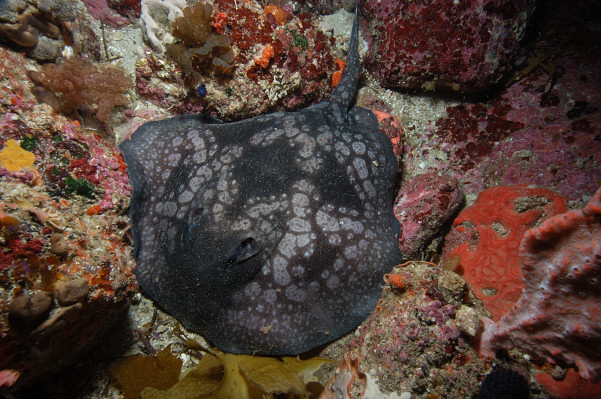|

Photograph copyright Andy
Murch
View more
Spotted Stingaree Pictures
in the
Shark Pictures Database
Common
Names: Spotted stingaree
Latin Name:
Urolophus
gigas
Family:
Urolophidae
Identification:
Disc round without prominent point on snout. Roughly circular, light grey, broken spots
create a pattern covering most of the black or darker dorsum. Usually dark in front of eyes,
and centrally behind eyes extending into two dark patches on real half of
pectoral fins. Pattern of spots extends
along tail.
Size:
Maximum
length approx 70cm.
Habitat: 2 - 50m.
Often seen buried in sandy sea grass areas. The specimen above was
deeply hidden under a rocky reef.
Abundance
and distribution:
Southern Australia, from Victoria and Northern Tasmania to at least Albany, WA.
Uncommon.
Behavior:
Buries during the day.
Reproduction:
Ovoviviparous.
Conservation
Status: Listed as 'Least Concern' by the IUCN. This species
appears to be naturally uncommon with a patchy distribution,
exhibiting clustering across a relatively broad geographical area.
Specific habitat requirements need to be elucidated to determine
actual area of occupancy. The biology of this species is largely
unknown. It is sometimes caught by otter trawling and gillnets in
southeastern Australia, but catches are likely to be small and
overall catch susceptibility in these fisheries is considered to be
low. Across the major portion of the species' range, fishing
pressure is low or absent (i.e., inshore areas of the Great
Australian Bight). Furthermore, its occurrence around rocky reefs
will provide refuge from trawling. Given that it is naturally
uncommon, any increases in catches in the future would need to be
closely monitored. At present, however, with a widespread southern
Australian range, most of which receives little fishing pressure,
the species is assessed as Least Concern.
Photographs:
Albany, Western Australia.
Similar
species: Circular stingaree
- Urolophus circularis
shares its western range. A rarely encountered species exibiting a
distinct pattern of circular spots similar to U. gigas.
Reaction
to divers: The specimen above completely ignored the photographer but
this species may be more skittish when encountered in the open.
Diving
logistics: Divers usually
encounter this species while swimming over sea grass beds. Anywhere in the
southern Australian area is probably good for sightings. As I have
only encountered this specimen in WA I would like information on common sighting
areas further east.
Citations:
Last, P.R. &
Marshall, L.J. 2006. Urolophus gigas. The IUCN Red List of
Threatened Species 2006: e.T60094A12246413.
http://dx.doi.org/10.2305/IUCN.UK.2006.RLTS.T60094A12246413.en
.
HOME
LINKS
TAXONOMY
BOOKS
CONTACT
|






















